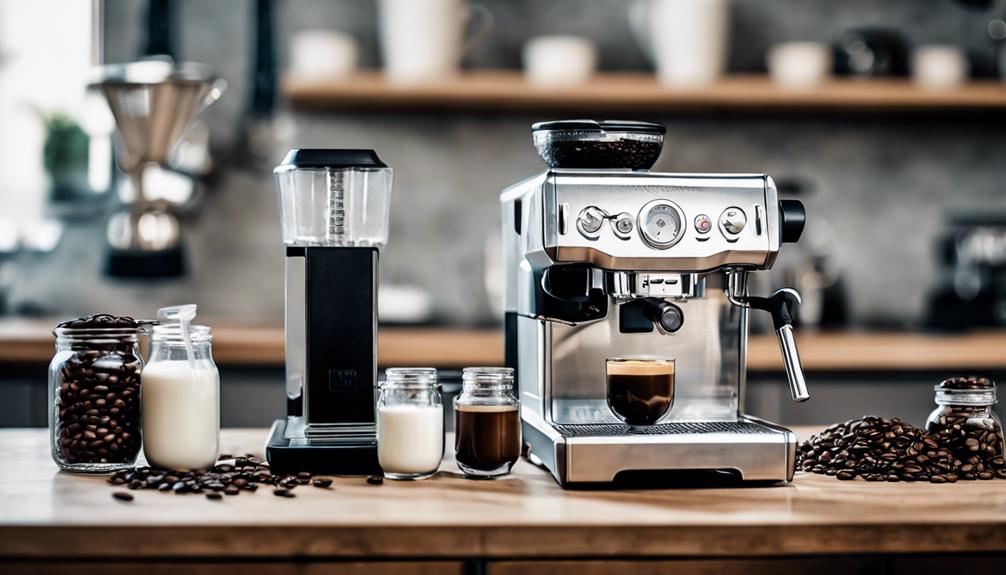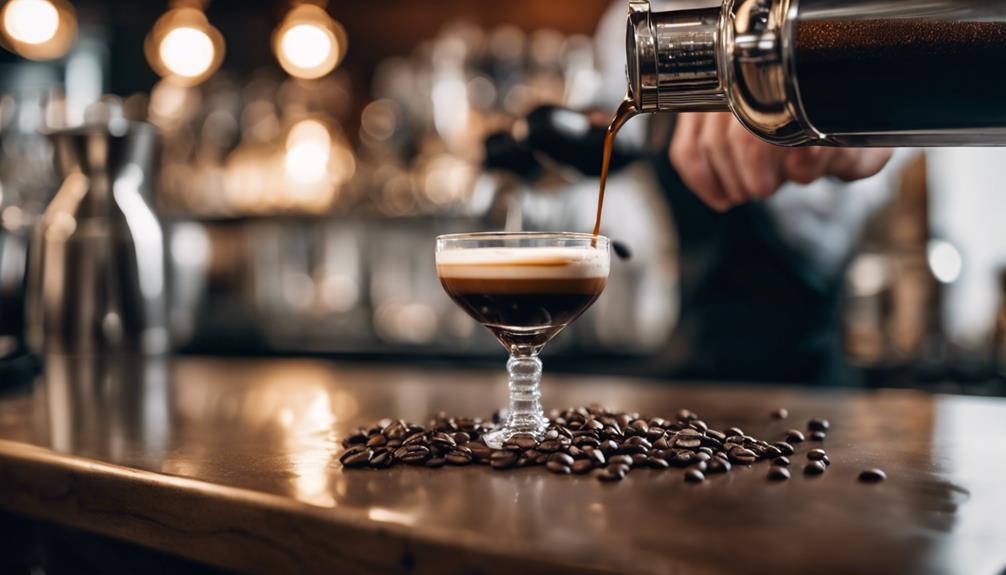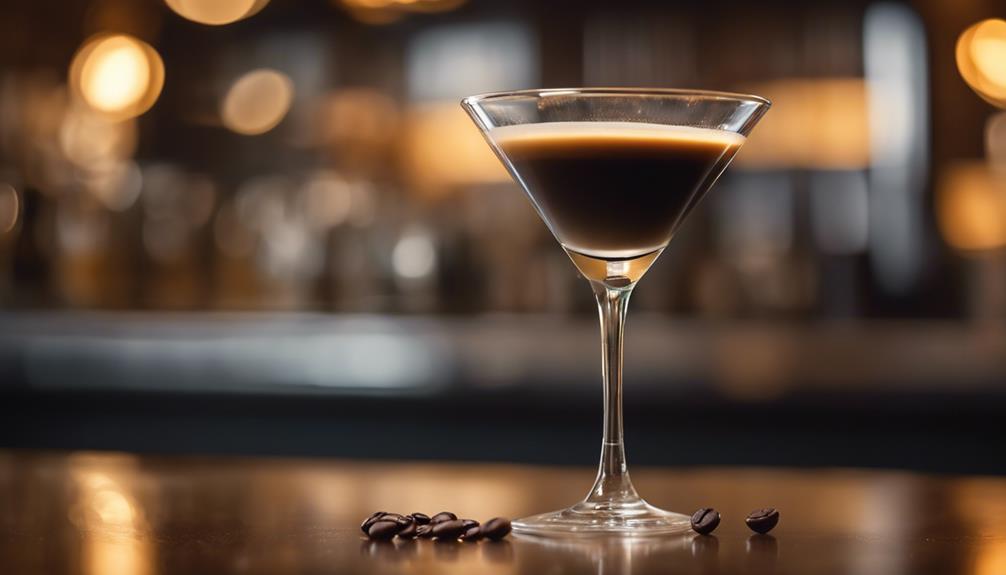When comparing espresso and lattes, pay attention to the milk-to-coffee ratios: lattes tend to have a ratio of 2/3 steamed milk, while espresso remains strong. Texture is also a factor, with lattes providing a creamier feel compared to the frothy lightness of cappuccinos. The frothing methods differ – lattes favor microbubbles, while cappuccinos go for airy foam. Lattes are known for their creaminess, while espressos have a silky consistency. Steaming creates smoothness, while frothing results in fluffiness. Espresso is known for its bold flavor, while lattes are loved for their creamy richness. There are customization options like syrups for lattes and frothy toppings for cappuccinos. Delve deeper to discover more subtle differences between these caffeinated beverages.
Key Takeaways
- Espresso is a concentrated coffee shot, while lattes are espresso-based drinks with steamed milk.
- Lattes have a creamier texture due to more milk, while espressos offer a bolder flavor.
- Cappuccinos contain equal parts espresso, steamed milk, and foam, unlike lattes and espressos.
- The serving sizes differ, with lattes in larger cups, cappuccinos in smaller cups, and espressos in tiny cups.
- Customization options like syrups and toppings are more common in lattes compared to espressos.
Milk-To-Coffee Ratio Differences
When comparing espresso-based beverages, the milk-to-coffee ratios play an important role in distinguishing between a latte, cappuccino, and flat white.
A latte typically consists of 1/3 espresso and 2/3 steamed milk, creating a creamy and smooth texture.
In contrast, a cappuccino maintains a balance with 1/3 espresso, 1/3 steamed milk, and 1/3 frothed milk or microfoam, resulting in a more velvety and airy consistency.
The flat white, with its origins in New Zealand and Australia, deviates from the traditional ratios by featuring a double shot of espresso combined with 2/3 steamed milk topped with microfoam, offering a rich and intense flavor profile.
Understanding these distinct milk-to-coffee ratios is essential in appreciating the unique characteristics of each beverage.
Whether you prefer the milk-forward latte, the well-balanced cappuccino, or the bold flat white, the ratios of these espresso drinks contribute significantly to their taste, texture, and overall experience.
Texture Variations
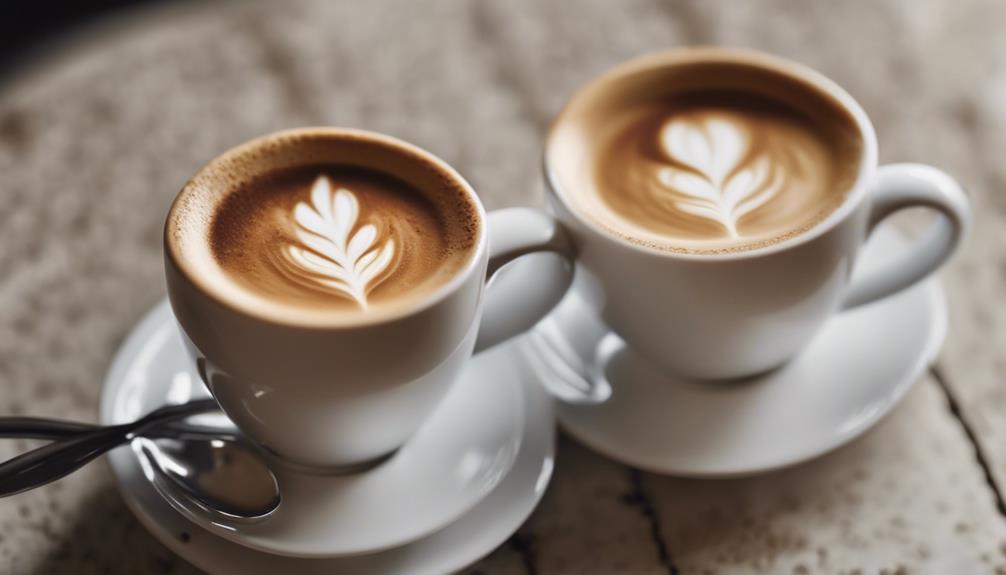
When comparing texture variations between espresso-based drinks like lattes and cappuccinos, you'll notice distinct differences. Lattes tend to have a creamier texture due to the steamed milk, while cappuccinos offer a lighter and airier feel with frothed milk on top.
Understanding these distinctions can help you choose the perfect espresso drink based on your preference for froth versus foam and creamy versus silky textures.
Froth Vs. Foam
Distinguishing between froth and foam in espresso-based drinks is essential for understanding the varying texture nuances between lattes and cappuccinos.
In a latte, froth refers to a thin layer of microbubbles on top of steamed milk, contributing to a creamy texture and visual appeal. This froth is achieved by aerating milk with steam, resulting in a smooth and velvety finish that enhances the overall flavor profile when mixed with espresso.
On the other hand, cappuccinos feature foam, which is frothed milk with a light and airy texture, creating a thicker layer on top that provides a distinct taste and mouthfeel. The foam is produced by frothing milk to incorporate air bubbles, giving cappuccinos their characteristic frothy top layer.
Understanding the difference between froth in lattes and foam in cappuccinos is essential for appreciating the unique textures and tastes each espresso-based drink offers.
Creamy Vs. Silky
Understanding the texture variations between lattes and espressos is essential for appreciating their distinct flavor profiles. Lattes, with their creamy texture from the higher milk content, offer a comforting and indulgent experience. On the other hand, espressos are silky, providing a thicker consistency that complements their intense flavor. The contrast in mouthfeel between the two beverages enhances the overall drinking experience for coffee enthusiasts.
To further illustrate the difference between a latte and an espresso regarding texture, let's compare them in a table:
| Aspect | Latte | Espresso |
|---|---|---|
| Texture | Creamy due to foamed milk | Silky with a thicker consistency |
| Flavor Profile | Milder and indulgent | Concentrated and strong |
| Milk Content | Higher (2/3 of the drink) | Minimal |
| Serving Size | Larger | Smaller |
| Preparation Method | Steamed milk poured over a shot of espresso | Pressurized hot water through finely ground coffee beans |
The texture variation is a key factor in distinguishing lattes from espressos and contributes significantly to their unique characteristics.
Steaming Vs. Frothing Techniques
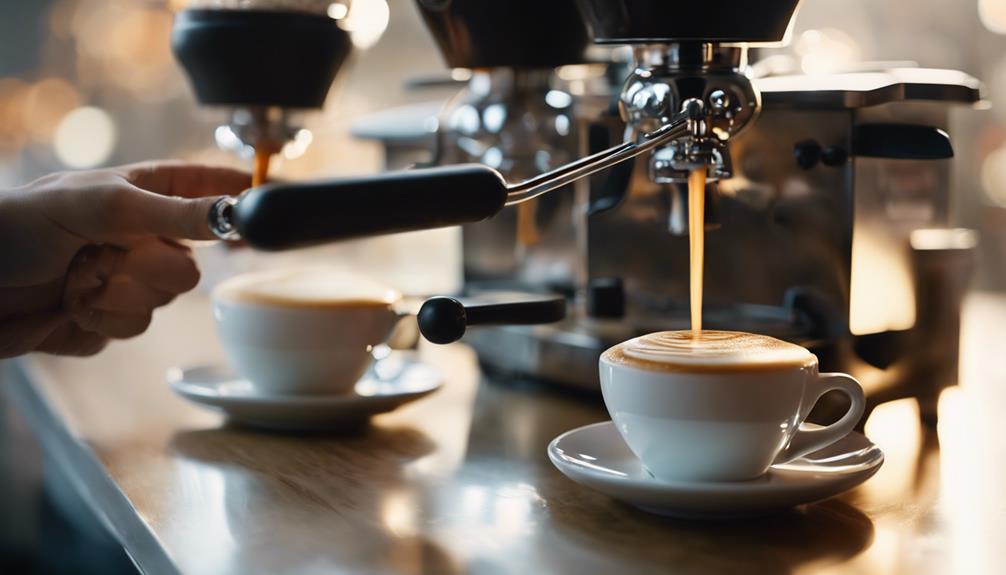
For espresso and latte siblings, mastering the difference between steaming and frothing techniques is vital in achieving their distinct textures and flavor profiles.
When it comes to espresso drinks, the steaming technique involves heating and texturing the milk to create a smooth, creamy consistency, known as steamed milk.
In contrast, frothing milk for a cappuccino requires aerating the milk to produce a thick, fluffy layer of milk foam on top of the drink.
In a latte, the steamed milk contributes to its creamy texture and milder flavor profile. On the other hand, the frothed milk in a cappuccino adds a light, airy texture and a distinct layer of foam, enhancing the coffee's taste.
The goal of steaming milk for lattes is to seamlessly blend the milk and espresso, resulting in a harmonious combination. Conversely, the frothing technique for cappuccinos creates a clear separation between the foam and espresso, offering a different drinking experience.
Mastering these techniques is essential in creating the perfect espresso or latte drink tailored to your preferences.
Espresso Strength Vs. Milk Creaminess
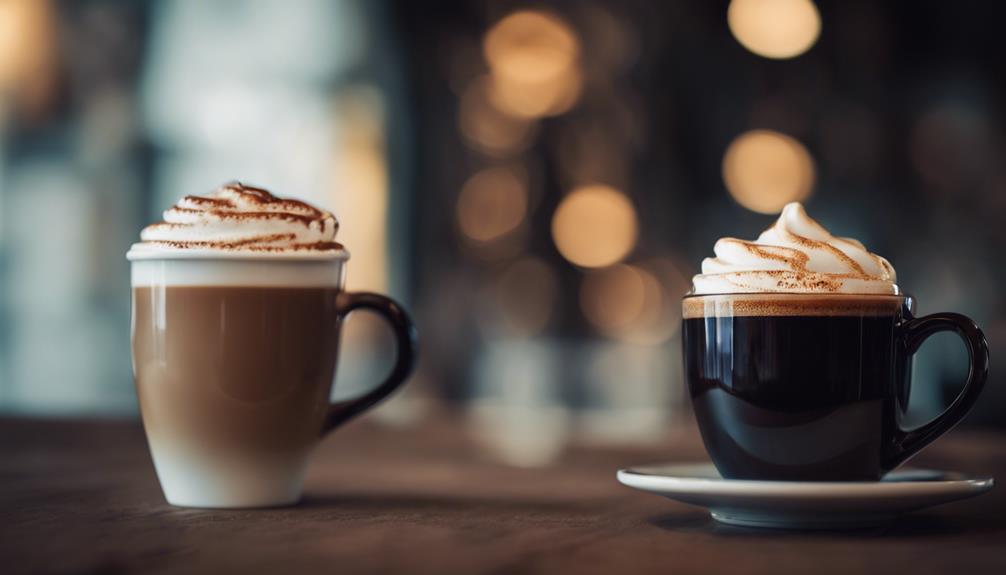
Espresso's bold flavors and high caffeine content contrast with the creamy, milk-rich profile characteristic of a latte. When comparing espresso strength to milk creaminess:
- Espresso focuses on intense, robust flavors that highlight the pure essence of coffee beans.
- The concentrated shot of espresso delivers a powerful caffeine kick, distinct from the smoothness of a latte.
- Latte achieves its creaminess through steamed milk, creating a velvety texture that complements the bitterness of espresso.
- The strength of espresso lies in its concentrated flavor, while the creaminess of a latte adds a comforting element to the drink.
- Espresso emphasizes rich, complex coffee notes, whereas a latte enhances the beverage with a creamy, indulgent touch.
Understanding the interplay between espresso strength and milk creaminess is key to appreciating the distinct characteristics of these popular coffee siblings.
Flavor Profiles Compared
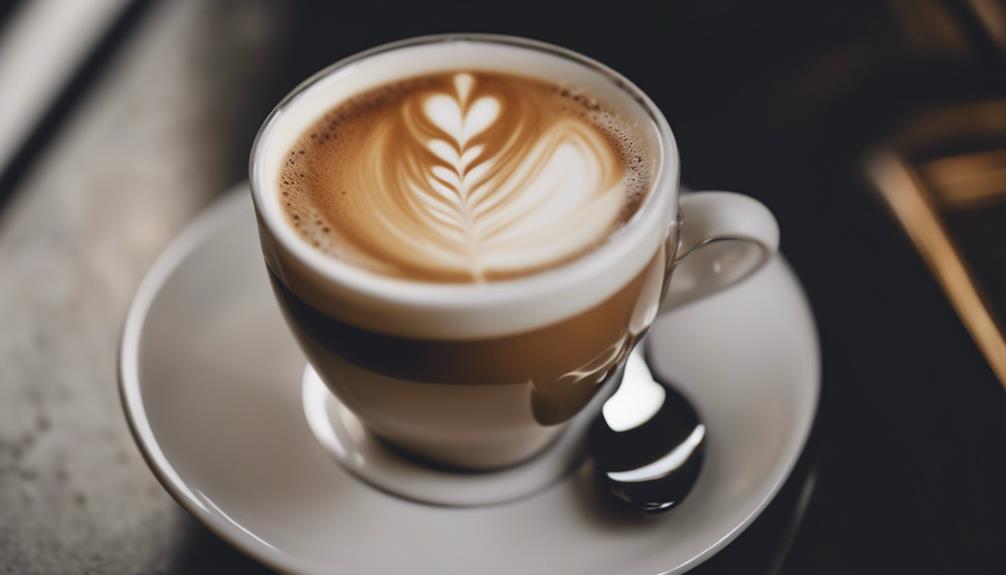
Espresso brings a bold and intense flavor profile, showcasing the concentrated shot of coffee.
In contrast, latte offers a smoother and creamier taste due to its higher milk content.
The balance of intensity levels and milkiness factor contribute to the dynamic flavor profiles of these popular coffee siblings.
Espresso Intensity Levels
With its bold and intense flavor profile, espresso stands out as a concentrated shot of coffee that delivers a rich and robust taste experience. When comparing the intensity levels of espresso and lattes, it's important to recognize how the concentration of coffee and the ratio of milk play a vital role in defining their distinct flavors.
Here are some key points to keep in mind:
- Espresso boasts a strong and pure essence of coffee, offering a powerful caffeine kick and a distinct coffee taste.
- Lattes, on the other hand, provide a milder flavor profile by blending espresso with steamed milk, resulting in a smoother and creamier taste.
- The intensity of espresso lies in its minimal dilution, showcasing the concentrated nature of the coffee.
- Lattes achieve a more balanced flavor by harmoniously combining espresso with a generous amount of milk.
- The difference in intensity levels between espresso and lattes caters to varying preferences for boldness and creaminess in coffee beverages.
Latte Milkiness Factor
When comparing lattes to other coffee beverages like espresso, the milkiness factor plays a significant role in defining their flavor profiles. Lattes are known for their higher milk content, creating a smoother and creamier texture compared to other coffee drinks. The milk-to-espresso ratio in lattes is typically 2/3 milk to 1/3 espresso, giving them a milder coffee flavor that appeals to those who enjoy a gentler taste.
The milkiness of lattes enhances the coffee's subtle flavors and aromas, making them a popular choice for those seeking a balanced and comforting drinking experience. Due to their increased milk content, lattes have a velvety texture and a sweeter taste, providing a creamy coffee beverage option that stands out for its smoothness.
Originating in America, lattes are often served in larger cups or glasses to accommodate the higher milk content, showcasing their unique milkiness factor in the coffee world.
Flavor Balance Dynamics
In comparing the flavor balance dynamics of lattes, cappuccinos, and flat whites, each coffee beverage showcases unique characteristics that cater to different taste preferences. When it comes to flavor profiles, lattes, cappuccinos, and flat whites offer diverse experiences due to variations in their milk-to-coffee ratios and textural components.
Here's a breakdown to help you understand the differences:
- Lattes: Known for a smoother, creamier texture with a higher milk-to-coffee ratio, lattes emphasize the milk's sweetness and creaminess, enhancing the coffee's subtle notes.
- Cappuccinos: Offering a balanced blend of espresso, steamed milk, and frothed milk, cappuccinos achieve a harmonious balance between bold espresso, creamy steamed milk, and airy frothed milk, creating a rich and creamy drink.
- Flat Whites: Prioritizing a strong espresso flavor with a velvety texture and using less milk than lattes or cappuccinos, flat whites deliver a robust coffee experience with a smooth finish.
These distinctions in flavor dynamics make each coffee variant a unique and delightful choice for different preferences.
Serving Sizes Distinction
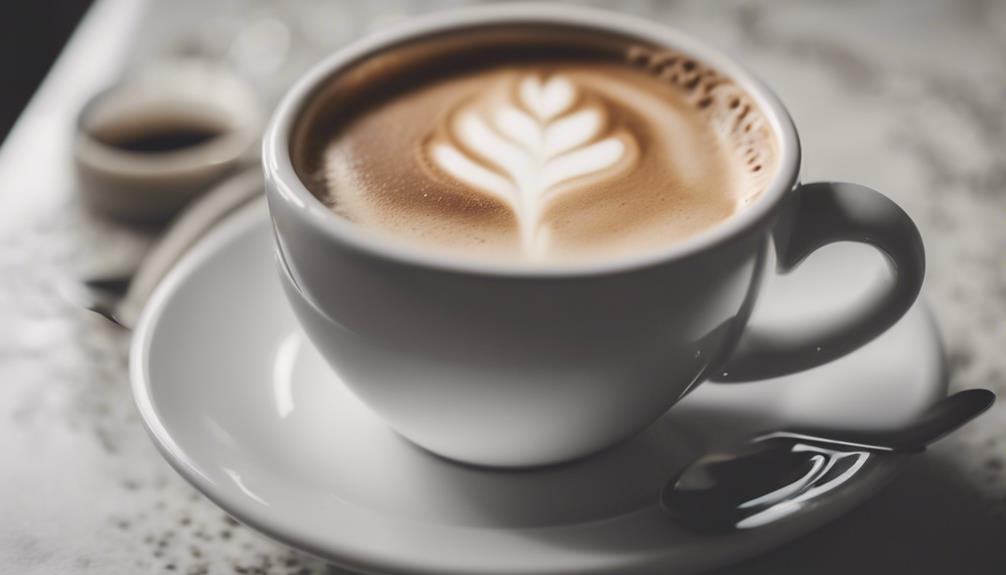
Let's explore the differences in serving sizes between espresso and latte variations.
When it comes to latte and cappuccino serving sizes, there's a noticeable distinction. A latte is typically served in a cup or glass of 240 ml, providing a generous amount of the creamy espresso-milk blend.
In contrast, cappuccinos come in smaller cups ranging from 150-180 ml, emphasizing a more concentrated and intense flavor profile. The smaller layer of a cappuccino allows for a unique texture, with distinct layers of espresso, steamed milk, and milk froth creating a delightful balance of flavors.
This contrasts with lattes, where the ratio of milk to espresso is 2/3 steamed milk to 1/3 espresso, resulting in a smoother and creamier texture.
Flat whites, akin to cappuccinos, maintain the smaller serving size characteristic, offering a rich espresso flavor with minimal milk and foam, making them a popular choice for those seeking a stronger coffee taste in a smaller cup.
Popular Customization Options
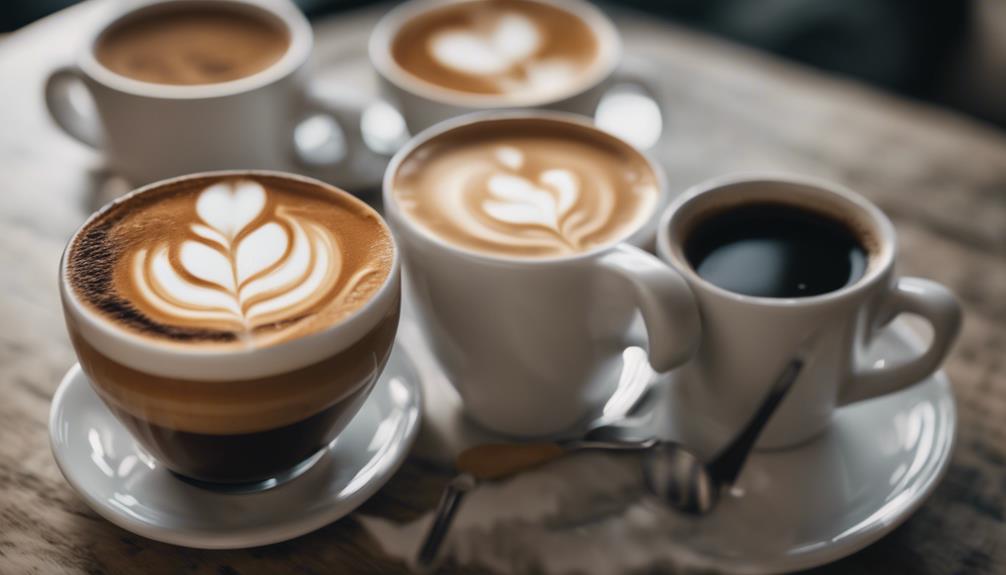
You can elevate your espresso or latte experience by exploring a variety of popular customization options. Here are some ways to personalize your coffee drinks:
- Flavored Syrups: Enhance your latte with syrups like vanilla, caramel, or hazelnut for a sweet twist.
- Toppings: Add a touch of indulgence to your cappuccino with toppings such as cocoa powder, cinnamon, or chocolate shavings.
- Alternative Milk: Customize your flat white by opting for almond, soy, or oat milk for a dairy-free alternative.
- Espresso Strength: Adjust the strength of the espresso shot to tailor the flavor of your latte or cappuccino to your preference.
- Foam Density: Experiment with the foam density in your cappuccinos and flat whites to create different textures and mouthfeels, enhancing your overall coffee experience.
Frequently Asked Questions
What Is the Difference Between Espresso and Latte?
Espresso and latte differ mainly in their milk-to-coffee ratios and serving sizes. Espresso has a higher coffee concentration with a 1/3 milk ratio, served in small cups.
Meanwhile, a latte has more milk (2/3 steamed milk), served in a 240 ml cup. Additionally, the foam in a latte is smaller, while espresso features milk froth.
These distinctions showcase the unique characteristics and origins of these popular coffee beverages.
Are Latte Cookies and Espresso Cookies Related?
No, Latte Cookie and Espresso Cookie aren't related. They're friends and research partners, not siblings.
A fun example to illustrate this is imagining them as colleagues in a coffee shop, brewing up new cookie recipes together. While they've a unique bond, it's based on their shared interests and personalities, not a familial connection.
Their relationship adds a delightful dynamic to the Cookie Run universe, showcasing friendship and collaboration.
What's the Difference Between a Latte and a Regular Coffee?
Regular coffee is brewed without milk, while a latte combines espresso with steamed milk.
The texture of a latte is creamy and smooth, unlike the plain consistency of regular coffee.
Lattes have frothed milk on top for visual appeal, while regular coffee is typically foam-free.
Lattes come in cups or glasses of 240 ml, while regular coffee is served in standard mugs.
The taste of a latte is a blend of espresso's strength and milk's sweetness, offering a more complex flavor than regular coffee.
Does a Latte Always Have Espresso?
Yes, a latte always contains espresso in its recipe.
The espresso forms the base of this creamy coffee drink, providing a robust flavor that stands out. Typically, a single or double shot of espresso is used in a latte.
The espresso is then mixed with steamed milk to create the perfect balance of richness and creaminess that defines a classic latte.
What are the key differences between Vietnamese coffee and traditional espresso?
When it comes to vietnamese coffee versus espresso differences, the main distinctions lie in the brewing method and the ingredients used. Vietnamese coffee is typically made with condensed milk and robusta beans, giving it a sweet and creamy flavor. On the other hand, traditional espresso is made with arabica beans and has a bolder, more intense taste.
What are the key differences between Vietnamese coffee and espresso, and how do they compare to lattes?
When it comes to Vietnamese coffee versus espresso choices, the key differences lie in preparation and taste. Vietnamese coffee is often made with sweetened condensed milk, creating a rich and sweet flavor, while espresso is a concentrated shot of coffee with a bold, intense taste. Lattes, on the other hand, are made with espresso and steamed milk for a creamy, milder flavor.
What Makes Doppio Different From Espresso and Latte?
When it comes to espresso vs doppio differences, the main distinction lies in the amount of coffee used. A doppio is simply a double shot of espresso, providing a stronger and more intense flavor compared to a single shot. This makes doppio a great choice for those who prefer a bolder coffee taste.
Conclusion
To sum up, the differences between espresso and latte siblings are clear when considering their milk-to-coffee ratio, texture, steaming techniques, strength, flavor profiles, serving sizes, and customization options.
Understanding these distinctions can help you choose the perfect coffee beverage to suit your preferences. Whether you prefer a strong shot of espresso or a creamy latte, knowing the unique qualities of each can enhance your coffee-drinking experience.
Choose wisely, and enjoy your next cup!

